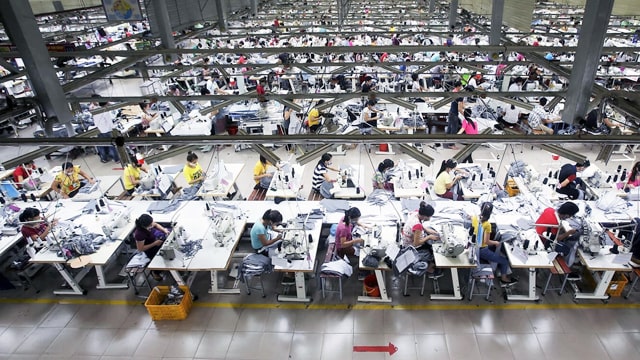While industry practitioners often feel these are contrasting aspirations (meaning production and quality cannot be improved simultaneously), consultants and gurus preach improvement in both simultaneously. This data shows key performance indicators related to various functions performed by the production staff. Management is able to use this data to provide reports, evaluate employee performance, set goals, recognize trends, project future metrics and much more.
This article is by Mausmi Ambastha, Founder and COO of ThreadSol, with several years of experience as a consultant with industry expertise in Sewing, Merchandising, Inventory Control and Supply Chain Management.
Man to Machine Ratio (MMR)
Man to Machine Ratio is defined as the total available workforce in a factory/organization to the number of operational machines. Companies are following/setting benchmarks MMRs for their factories to optimize and hence further control the ever increasing cost of manufacturing.
The benchmark value can vary greatly, depending upon the production system, product and quality parameters and the measurement system followed.
It is advisable for each factory to develop their own benchmarks and strive to reduce them. Alok Apparels have maintained their man-machine ratio well below 1.5:1 as stated on their website. Noble Garments of Bahrain have a man-machine ratio of 1.85:1.
Many factories also consider a man-machine ratio comprising of total employees in the company in the numerator. This gives them an indication of the total investment that the company is making on people for each machine in the factory. Various other accounting measurement figures can emerge from here.
Example: Factory XYZ has 100 sewing machines. Total direct labour in the factory is 150 and total manpower in the factory is 200. Therefore, man-machine ratio as per direct labour is 1.5:1 and man-machine ratio as per total manpower is 2:1.
Work in Progress (WIP)
Work in Progress is inventory that has entered the manufacturing process and is no longer included in the raw material inventory, but is not yet a complete product. WIP can be measured in the whole factory, in a production line or between two operations. WIP can be measured in terms of number of pieces or number of minutes of workload.
Work in Progress in line = Total number of pieces in the line (pieces)
This can be done by simply counting pieces in the line or subtracting the total number of pieces loaded to total number of pieces unloaded from the line.
Work in Progress in cutting = Total number of pieces in the cutting (pieces)
Alternatively, the total number of pieces that have been issued from the cutting room could be subtracted from the total number of pieces for which fabric has been issued to cutting room.
Work in Progress between two operations = No.of pieces X SMV (minutes)
On a balance sheet, Work in Progress is considered to be an asset because money has been spent towards a completed product. Because the product has not been completed, however, WIP is valued lower. There are different schools of thought regarding the amount of WIP that should be in a line and each has their own benefits. A lean system insists on minimum or single piece WIP between operations. A bundle system suggests approximately 30 minutes of work in progress between two operations.
Example: Line A in factory XYZ was loaded with 200 pieces of style 1 and 500 pieces of style 2. The factory had given an output of 150 pieces of style 1 and 0 pieces of style 2. Therefore, WIP = 550 pieces (200-150 = 50) + 500 = 550
Takt Time
The Takt Time concept aims to match the pace of production with customer’s demand. The purpose of Takt Time is to match production precisely with demand. It provides the heartbeat of a lean production system.
![]()
Example: A single 8-hour shift = 480 total minutes. The start-up process in the morning = 10 minutes, and shut-down and clean up at the end of the shift = 15 minutes. This 25 minutes is not production time, so it is subtracted from ‘available minutes’ (480 -25 = 455). So we would use 455 minutes as the baseline for calculation.
If the customer’s demand was 300 units per day, then the takt time would be: 455 available minutes/300 required units of production, i.e.1.52 minutes.
This time can be used to balance operations and operators to make them close to the Takt Time thereby creating a more balanced line. The concept was widely utilized within Toyota in the 1950s and was in widespread use throughout the Toyota supply base by the late 1960s.
Throughput Time/Flow Time
The Throughput by Flow Time is the amount of time required for a product to pass through a manufacturing process, thereby being converted from raw materials into finished goods. This can be measured by identifying a garment and noting down the time when it enters the production line and finally exits the production line after processing. The time that the garment remains in the production line is known as throughput time.
This concept can also be applied to a part or a sub assembly. Throughput time consists of the following:
a. Processing time
b. Inspection time
c. Movement time
d. Queue time/Waiting time
In order to decrease throughput time and thereby increasing the system’s output, one should try to reduce one of the four above mentioned times. It is often noted that the bulk of the time is spent not in processing, but on inspection, movement and waiting. Therefore, throughput time can be reduced by focussing on reduction of one of the three other times.
Example: A production line consisted of five operations of two minutes each where the fifth operation was end-line inspection. WIP between each operation was 10 minutes and movement time between the fourth and fifth operation was 3 minutes.
Processing time = 8 minutes
Inspection time = 2 minutes
Movement time = 3 minutes
Waiting time = 40 minutes
Therefore, total throughput time = 53 minutes.
Throughput Rate/Flow Rate
The Throughput or Flow Rate is the average rate at which units flow past through a specific point in the process. This is the rate at which the system achieves its goals.
![]()
The unit of throughput rate is output per unit time. The maximum throughput rate is the process capacity.
Hourly output is measured in almost every factory; throughput rate is simply an average rate of output.
Example: Factory XYZ has daily output of 450 pieces in Line A and the line works daily for 8 hours. Therefore, throughput rate is 450/8=56 pieces per hour.
Machine Utilization
Machine utilization is the time when the machine is actually being utilized for the purpose of production. This is a simple measure to see how much time is being utilized at the machine and how much time is spent in handling or preparation for the machine.
![]()
Actual running time: Actual running time is the time spent on running the machine in each cycle (for a sewing machine, this is the only time when the needle is moving) x pieces produced per shift or per day.
Time Available: Time Available is the total working time in the shift or the day. (This will exclude any non-working time, machine downtime, etc).
In a sewing line, the only time when the needle is moving is the time when the system is actually producing garments. Otherwise, it is either idling or doing other non-productive work.
Machine utilization may vary from style to style (fabrics that require more handling will have lower machine utilization), its level of automation, the type of production system, line layout, etc. This metric should be used in view of all other factors involved.
Example: Style 1 , operation 5 had a total SMV of 1.5 minutes out of which total machine time is 0.65 minutes. The operation produced 220 pieces per day.
Time available = 480 minutes – 20 minutes of machine downtime and 10 minutes of non-working time.
Therefore, machine utilization = (0.65 X 220) X 100 / 450 = 31.7%
Overall Equipment Effectiveness (OEE)
Overall equipment effectiveness is another metric which is increasingly being adopted by the garment industry.OEE is a crucial measure in TPM that tells you how well your equipment is running. It links three elements in one percentage: the time the machine is actually running; the level of utilization of the machine as running time and the quality of good output.
OEE = Availability X Performance X Quality
a. Availability compares the actual time the equipment was producing parts (uptime) to the time it was scheduled to produce parts (scheduled production time)
Total available (operating) time = Planned production time – (Down time+Unscheduled time)
![]()
b. Performance compares actual production versus the standard number of pieces that should have been produced.
![]()
c. Quality emphasises conformance to quality standards.
![]()
In an article published in Journal of Mechanical Engineers, Bangladesh in June 2007 titled“Total productive maintenance in RMG Sector: A Case Study: Burlington Ltd., Bangladesh,” OEE, was calculated in the garment factory at 59%. The factor was successfully utilized to identify problems and achieve an improved OEE of 65%. The article further claimed that OEE could be further improved to 85% by eliminating all detrimental causes. 85% is considered as a standard for Japanese industries.
SMV Improvement
SMV Improvement is the percentage reduction of standard time of the garment. The IE team’s job involves scrutinising each operation on the line and trying to improve the operation. This can be done by method improvement, workplace engineering, applying new machinery or attachment, garment engineering, etc.
![]()
If the factory knows cost/min., then this can be directly interpreted as money.
Money saved/day = Number of minutes saved x pieces produced per day x cost/min.
The above saving can only be realized if the method in the new SMV is adopted by the operators and production takes place according to the new system. This is commonly used by the IE Department to evaluate the improvement made by its members and to establish their contribution to the company.
Value Added Time (VA): In Lean philosophy, ‘value’ is determined by customer’s point of view. It refers to what the customer is willing to pay for and what creates value for the end product. A value adding element is one which is carried by the final product. Value added processes are those which are essential for conversion of raw material into finished products as per the customer’s demand.The time taken to do the value adding process is known as value added time.
Example: cutting, sewing etc.
Non-Value Added Time (NVA): Non value added work, also called waste, refers to work that doesn’t add value to or is unnecessary for the overall product.
A non-value adding element is not carried by the final product. It may not be possible to eliminate all non-value adding elements. The process needs to analyze and decide which NVA works are essential and which can be eliminated. An example is notches used for matching of parts. A notch is not a value addition to the product, but it is required to ensure correct matching quality. Therefore, it is an essential NVA work. Waiting time can be termed as non-essential non-value added work.
Value Stream Mapping: Elimination of the waste from a process can take place only after identification of waste material. Value stream mapping is the process of categorising a complete chain of process into Value Added Work (VAW) and Non Value Added Work (NVAW).
Lost Time: Lost Time is described as the time lost by the operators for which they are not responsible. A minute here and there may not seem much, but when added, this can result in a major chunk of lost production. There can be various reasons for lost time. Some of them are:
a. Poor line balancing
b. Machine downtime
c. Lack of work
d. Unclear work instructions, etc. and all other delays that cause the operator to lose productivity.
It’s relatively easy to identify lost time in manufacturing. The key is to be able to measure it, estimate its value and take action to reduce or eliminate it altogether. Lower production cycle times means lower costs and increased production throughput. Eliminating lost time at every opportunity, regardless of how little it may be, will improve production and product gross profit.
Style Changeover Time
Style Changeover Time is the time taken to complete the process of changing between manufacture of one product to the manufacture of another product until the required production and quality parameters are satisfied. This can be measured at the end line inspection table as the time between the output of the last good piece of the previous style and the output of the first good piece of the next style.
A company working with adidas streamlined its average style changeover time to 27 minutes for a six minute garment by following SMED philosophy under a lean initiative.
Efficiency
Efficiency is the comparison of what is actually produced or performed with what can be ideally achieved with the same consumption of resources (money, time, labour, etc.)
![]()
Standard minutes earned = production achieved x standard time
One should understand that correct calculation of efficiency can only be achieved if the target production or standard time has been set based on standard internationally established systems. Otherwise, this figure becomes a gimmick and loses its real value.
Example: An operator worked for an 8 hour shift =480 mins. He lost 30 mins. for machine breakdown, 10 mins. for meeting and 30 mins. waiting for work. He did 22 bundles of 10 pieces during the shift. Standard time for the operation was 1.4 min. per piece.
Standard minutes earned = 22 X 10 X 1.4 = 308 minutes
Actual minutes attended = 480 – (30+10+30) = 410 minutes
Efficiency = 308/410 X 100 = 75.3%
Achieved production = 22 X 10 = 220 pieces
Target production @ 100% based on actual minutes attended = 410/1.4 = 292 pieces
Efficiency = 220/292 X 100 = 75.3%
Productivity
Productivity is the ratio of output produced and input resources utilized in the production. This is one of the most popular metrics in the industry.
![]()
Productivity can be measured as partial productivity wherein some of the factors are considered to simplify the calculation (i.e., for labour, material, etc.) or measured as total productivity or multi factor productivity where multiple inputs and outputs of resources are considered in a mathematically defined complex formula.
The garment industry mostly measures labour productivity in terms of output per machine per operator. This does give an indicative figure but one should refrain from comparing this figure from one factory to another unless both are producing same garments.
Efficiency and productivity are two very vast topics requiring comprehensive discussion. It is important to note though that productivity without efficiency is usually very expensive and efficiency does not always lead to productivity, neither is complete without the other.







